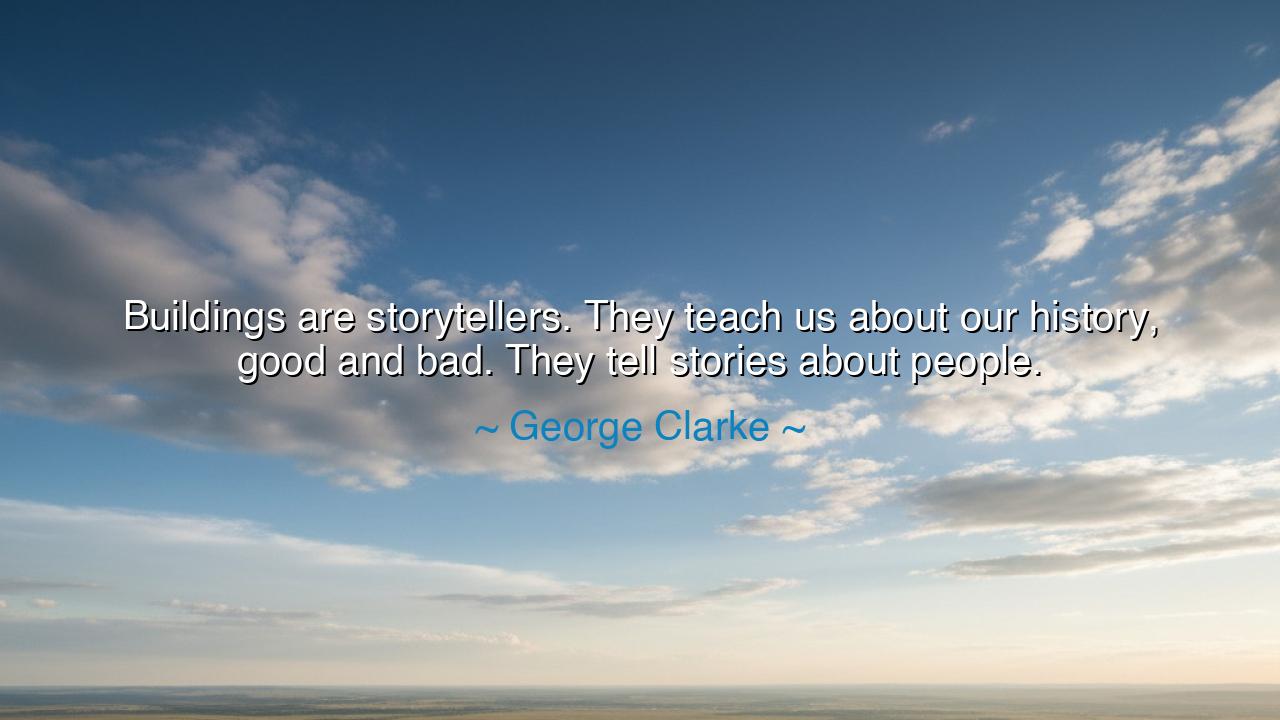
Buildings are storytellers. They teach us about our history, good
Buildings are storytellers. They teach us about our history, good and bad. They tell stories about people.






“Buildings are storytellers. They teach us about our history, good and bad. They tell stories about people.” – George Clarke
Thus spoke George Clarke, the architect and keeper of built memory, reminding us that the walls which surround us are not silent — they are storytellers, whispering the triumphs and tragedies of our past. In his words lies a truth both poetic and profound: that buildings are more than stone and timber, more than designs drawn by human hands. They are vessels of memory, teachers of history, and monuments to the souls of those who lived, dreamed, and labored within them. Through architecture, humanity has left not only shelter for the body but also testimony for the spirit.
To say that “buildings are storytellers” is to recognize that every structure, from the humblest cottage to the grandest cathedral, holds within it the breath of its makers. The grooves of the mason’s chisel, the arch of a doorway, the carvings on a column — all speak of a time, a people, a belief. The ancients built pyramids to honor the dead, temples to speak with gods, fortresses to defend kingdoms, and cities to proclaim their power. Each stone, each brick, each design was a sentence in the long poem of civilization. And even as empires fell, the buildings remained — patient witnesses to what was, enduring when memory faded.
Consider the Colosseum in Rome, that colossal ring of stone which still stands against the wear of centuries. To the traveler who gazes upon it, it tells many stories. Some are glorious — tales of Roman engineering, artistry, and ambition. Yet others are grim — stories of conquest, blood, and suffering, where men and beasts were slain for the joy of the crowd. Thus, as Clarke says, buildings teach us about our history, good and bad. The Colosseum, like all enduring architecture, is not a single tale but a chorus of human experience — the greatness and the cruelty intertwined, reminding us that history is never pure, that beauty and horror often share the same foundation.
In the East, the Taj Mahal tells another story — not of conquest, but of love. Built by Emperor Shah Jahan in memory of his beloved wife Mumtaz Mahal, its white domes gleam like moonlight over the Yamuna River. It is more than marble; it is grief made eternal, devotion carved into perfection. In its arches and gardens, we feel the heartbeat of a man who sought to capture love in stone. Through it, we learn that buildings tell stories about people — not only the powerful, but all those whose hands, hearts, and hopes shaped their creation. The masons, artisans, and laborers who worked upon its walls are as much a part of its story as the emperor who dreamed it.
Even the ruins of the humble — a weathered barn, an abandoned schoolhouse, a crumbling village home — are storytellers in their own right. They speak of lives once vibrant: the laughter of children, the call of the farmer, the gathering of families by the hearth. To listen to these buildings is to commune with the spirit of time itself. They tell us that history is not only written in books, but carved in walls and carried in beams. Where the written record ends, architecture continues the tale.
Yet, Clarke’s words are also a warning. For when we destroy or neglect our old buildings, we silence the storytellers of our past. To erase them is to lose pieces of our collective soul. Each demolition of heritage is not only the loss of art, but of wisdom. The stories of people — of courage, of toil, of faith — vanish with the dust. Thus, to honor history, we must protect its storytellers. We must restore where we can, and when we build anew, we must build with respect for those who came before, ensuring that our creations too will speak to those yet unborn.
So, my child of the modern age, remember this teaching: listen to the walls. When you walk through an old street, pause and let the buildings speak. Hear the rhythm of their years, the murmur of their memory. When you design or dwell, build not only for comfort but for meaning. Let your homes, your schools, your temples and towers, tell stories worthy of remembrance. For if books are the voice of the mind, then buildings are the voice of the soul — and through them, as George Clarke reminds us, the story of humanity continues to rise, stone upon stone, generation upon generation, eternal as the earth itself.






AAdministratorAdministrator
Welcome, honored guests. Please leave a comment, we will respond soon